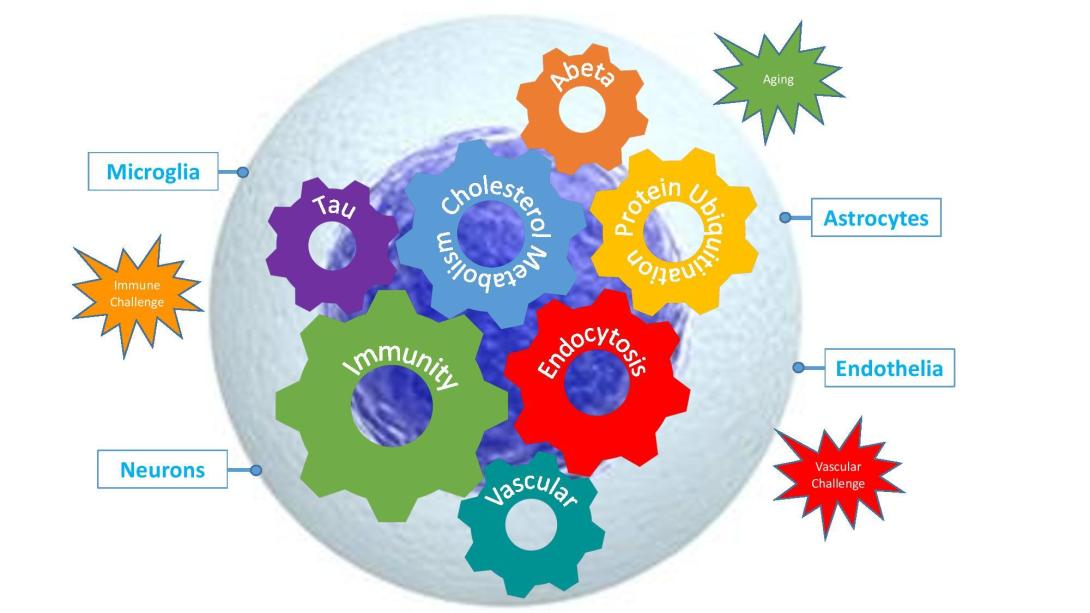Researchers led by UK DRI Centre Director Prof Julie Williams at Cardiff, have unveiled a new perspective on the potential triggers and drivers of Alzheimer’s disease (AD). Our growing knowledge of risk genes suggests multiple factors behind the condition, and clues for treatment development.
The review, published in Nature Neuroscience, outlines the Multiplex Model of the genetics of Alzheimer’s disease, which places genetics at the heart of the condition and key to finding new therapeutics. From Genome Wide Association Studies (GWAS), the field has identified over 50 genes that influence an individual’s risk of developing AD. Further mining into this data, using a method known as polygenic risk score (PRS), has revealed that there are several other genes that provide smaller contributions. However, when these are combined, they have a large and perhaps pivotal impact on overall risk.
By using this multiplex approach, we can pinpoint our research and work even faster towards reaching our goals.Prof Julie WilliamsCentre Director UK DRI at Cardiff
Alzheimer’s disease begins some 20 years before symptoms emerge, and calculating the combined effects of risk genes will help us identify people at highest risk in the earliest stages of disease where preventative therapies will have their greatest effect. Our advances so far now mean that PRS can potentially predict, with up to 90% accuracy, those likely to develop AD based on genetic profile alone.
Additionally, risk gene identification will help us unravel this complex disease in order to find much needed drug targets. By analysing disease pathways, researchers have already implicated several components including immunity and inflammation, the production and clearance of key proteins e.g. amyloid beta and tau, and cholesterol amongst others. Epidemiological evidence also points to a vascular role in disease.
The Multiplex Model has been devised by Centre Director at the UK DRI at Cardiff University, Prof Julie Williams and her team consisting of Dr Rebecca Sims and Dr Matt Hill. The centre’s strategy is to build upon their current research strengths in dementia genetics; immunology; computational analysis; cellular and whole system modelling and neuroimaging, to identify disease mechanisms and novel therapies for Alzheimer’s, Parkinson’s, Huntington’s diseases and other forms of dementia.

Depicting the biological processes (cogs) known to harbour genetic risk for Alzheimer's Disease, the disease specific cell types in which they act (blue boxes) and
Commenting on the perspective, Prof Julie Williams, said:
“Our research on the risk genes has helped us to an understanding of the key areas we should be looking at. We now know that the disease has a number of triggers and pathways to its development. By using this multiplex approach, we can pinpoint our research and work even faster towards reaching our goals.”
Dr Rebecca Sims added:
“The multiplex model reflects the combination of all known risk factors for disease - genes and environment - that could work in specific cells of the body at specific times in life to trigger or sustain a cascade of dysfunction in multiple processes. This cascade of dysfunction ultimately leads to the death of cells seen in Alzheimer’s disease that prompts the onset of disease symptoms.”
UK DRI Director, Prof Bart De Strooper, said:
“We are proud of this great overview of the genetic basis of Alzheimer’s disease from one of our world leading teams in the UK Dementia Research Institute. The huge progress in understanding the complex genetics underlying this condition will greatly help us in deciphering the early disease phases, when treatment intervention is most likely to be effective.
This further emphasises the need for a multi-angle, holistic approach to studying neurodegenerative disease. In order to make breakthroughs, we will have to harness wide-ranging expertise from across the research field, ensuring new knowledge gained is brought together to provide a complete picture of the causes and drivers of dementia.”
Article published: 9 March 2020
